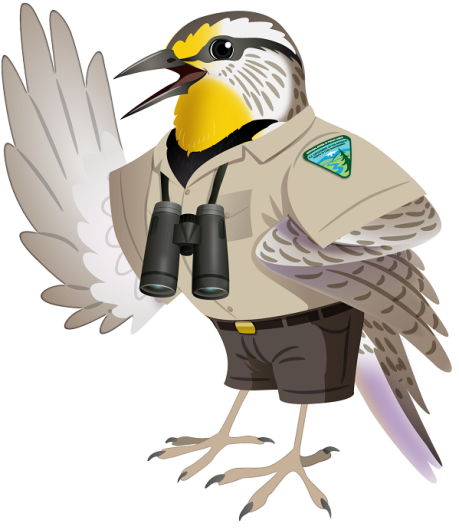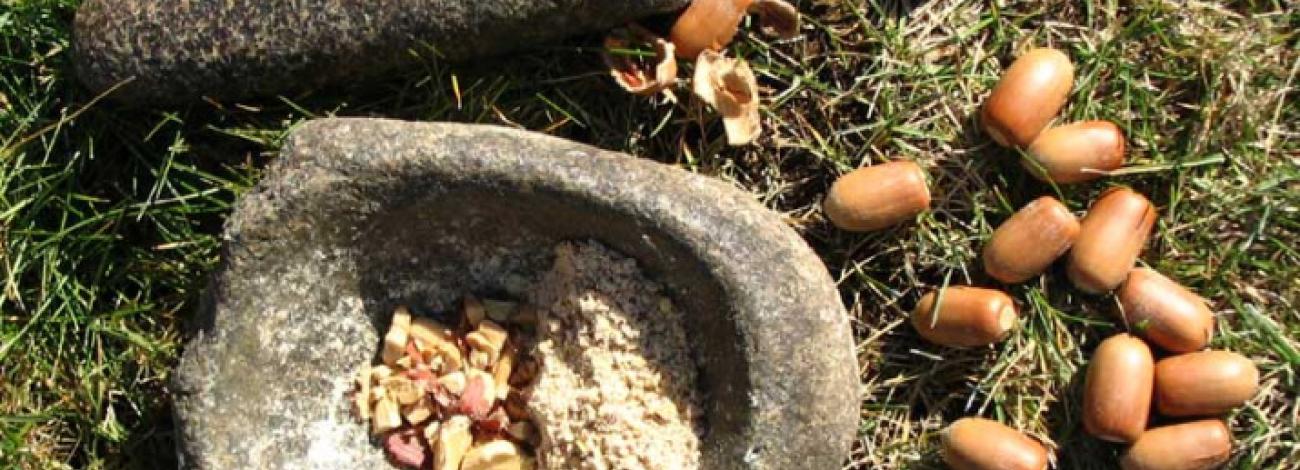
Seasonal Rounds
Settlement Patterns of the Takelma
The Takelma are considered a "hunting and gathering" society, in which bands of extended families move over the landscape as food sources seasonally become available. Generally, they traveled from the lower elevations in the spring to higher elevations during the summer and early fall, and then returned to their villages along the river for the winter. Each season represented a new round of food resources.
Spring
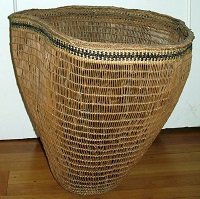
of Aleena Turpin
During the spring, the focus was on catching the spring run of salmon (Gray 1987:32).
Some methods used included hook and line, long nets used from canoes, dip-netting, and harpooning. Dams made of sticks were constructed across small channels with cone shaped baskets attached to the sticks. These baskets would catch the fish as they became trapped by the stick dam. Early white explorers remarked on how the Takelma captured spawning salmon from small streams by scooping them up by hand and tossing the fish onto the bank. Other foods harvested from the river included trout, steelhead, freshwater mussels, crayfish, and probably lamprey.
Spring was also the time to collect camas bulbs and basketry materials. Both men and women gathered and carried foods and materials in large woven baskets called "burden baskets."
Acorns gathered the previous fall were stored over the winter and processed into a valuable food resource in the spring.
Game animals included deer, elk, and rabbits were hunted with bows, atlatls, and snares and/or were driven into makeshift corrals. Waterfowl were also known to be eaten. Squirrels, chipmunks, and other small animals were sometimes hunted (Gray 1987:34).
Summer
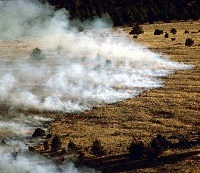
During the summer, the Takelma traveled the farthest, moving steadily up into higher, cooler elevations to collect bulbs, plants, and other items as they became available. As summer continued into fall, fruits, berries, nuts, and other plant products ripened and were harvested, including wild plums and serviceberries. A simple structure made of boughs and brush served as a temporary shelter as they traveled. In order to efficiently complete their tasks, the Takelma would divide into smaller task groups—typically women, youngsters, and a few older men for plant gathering, and men for hunting deer and elk. Because the work was rigorous and involved more travel, the elderly, sick, or pregnant would stay in the permanent villages in the valleys (LaLande 1991).
The summer was also an important time of year for individuals or small task groups to meet and trade. If staying away for extended periods of time, the Takelma would dismantle their plank houses, allowing the sun, wind, and rain to clean out the house before the people returned in the fall (LaLande 2004).
Tarweed and grasshopper burns were lit in the lower valleys during the late summer. The tarweed fields were burned at dusk, leaving the seedpods roasted and ready for harvest by the Takelma women. Areas known to have large grasshopper populations were burned, toasting grasshoppers, which were then collected for consumption (LaLande 2004).
Fall
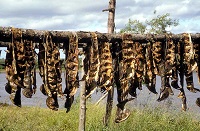
Much of the food gathered throughout the fall was dried and stored for the winter months. This was accomplished by cooking bulbs in underground ovens, roasting or smoking meat over a fire, or by using drying racks for numerous plant and animal foods. Acorns, pine nuts, hazelnuts, and deer/elk meat were all collected during the fall. After drying, many of the food items were ground with a grinding stone and then stored for winter use.
During the fall, the Takelma women conducted controlled burns called "cool burns."
These burns made acorns more visible for collecting, subdued encroaching vegetation in the oak savanna and chaparral, and kept grasslands open for foraging deer and elk populations. By burning the grasses, the Takelma women were also able to find and gather grasshoppers, as well as tarweed and other grass seeds (Gray 1987:34).
In addition, the cool burns supported new hazel and bear grass growth which are important basketry materials.
Winter

In the winter the Takelma moved down into the valley along the Rogue River and lived in semi-permanent rectangular structures covered in split sugar pine planks or bark slabs. Wooden steps, cut into a pole or a small log leaning inside the doorway, led down into the structure. The floors were made of packed dirt. The interior consisted of a ring of space around the inside at ground level, with an excavated pit area in the middle having a central fire hearth; the upper level formed a “shelf,” which served as a place to store baskets, wooden boxes, and other items. Reserves of food and supplies were suspended from the ceiling in order to keep them away from pests and allow them to remain dry with good air circulation (Beckham 1993; Sapir 1907b).
During the cold winter months, the Takelma often kept a fire going and, traditionally, the elders would tell the stories of their ancestors to the younger members of the village. In this way, their history, as well as the cultural beliefs of their people, is passed down from generation to generation. The Takelma women had time to weave and repair baskets. Men repaired hunting tools and made new ones. During these cold months, the Takelma also used their sweat houses, the men sometimes spending most of their time there, teaching various skills to their sons. Each village generally had a men's sweat house and sometimes a sweat house for women.
- References
-
Aiken, Melvin C.
- 1990 Southwest Oregon: Living With the Land. In Living With the Land: The Indians of Southwest Oregon. Nan Hannon and Richard K. Olmo, eds. Pp. 1-5. Medford, Oregon: Southern Oregon Historical Society.
Atwood, Kay
- 1994-95 As Long as the World Goes On: The Table Rocks and the Takelma. Oregon Historical Quarterly 95(4): 516-532.
Beckham, Stephen Dow
- 1993 Takelman and Athpascan Lifeways and History, Rogue River Corridor-Applegate River to Grave Creek: Investigations for Interpretive Programs. Eugene, Oregon: DOI Bureau of Land Management, Medford District Office.
Gray, Dennis J.
- 2003 Flounce Around Fuels Cultural Resource Inventory. Medford, Oregon: U.S.D.I. Bureau of Land Management.
- 1993 Analysis of the Fish Lake Artifact Collection, Site 35JA163, Jackson County, Oregon. Medford, Oregon: U.S.D.I. Bureau of Land Management.
- 1987 The Takelma and their Athapascan Neighbors: A New Ethnographic Synthesis for the Upper Rogue River Area of Southwestern Oregon. Eugene, Oregon: University of Oregon Anthropological Papers No. 37.
Kentta, Robert
- 2004 website edits. Cultural Resource Director for Confederated Tribes of Siletz Indians.
LaLande, Jeff
- 1991 The Indians of Southwestern Oregon: an Ethnohistorical Review Anthropology Northwest: Number 6. Dept. of Anthropology - Oregon State University, Corvallis.
- 2004 So, Just How Extensive was Anthropogenic Fire in the Pacific Northwest?: Southwestern Oregon as a Case Study. Eugene, OR. Paper presented at the Northwest Anthropological Conference.
LaLande, Jeff and Reg Pullen
- 1999 Burning for a ‘Fine and Beautiful Open Country’: Native Uses of Fire in Southwestern Oregon. In: Robert Boyd (ed.), Indians, Fire, and the Land in the Pacific Northwest. Oregon State University Press, Corvallis.
Pullen, Reg
- 1996 Overview of the Environment of Native Inhabitants of Southwestern Oregon, Late prehistoric Era. Medford, Oregon: DOI Bureau of Land Management, Medford District Office.
Sapir, Edward
- 1907a Religious Ideas of the Takelma Indians of Southwestern Oregon. Journal of American Folk-Lore 20:33-49.
- 1907b Notes on the Takelma Indians of Southwestern Oregon. American Anthropologist 9(2): 51-275.
Satler, Timothy
- 1979 Preliminary Report of Test Excavations at Salt Creek Site in Southwestern Oregon. Medford, OR: DOI Bureau of Land Management, Medford District Office.
Tveskov, Mark, Nicole Norris, and Amy Sobiech
- 2002 The Windom Site: A Persistent Place in the Western Cascades of Southwest Oregon. Ashland, Oregon: SOULA Research Report 2002-1.

